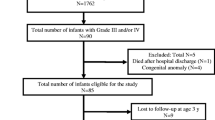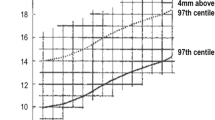Abstract
Thirty-six infants who developed grade III and IV intraventricular hemorrhages during the neonatal period were followed up to determine their developmental quotient. All of these infants had ventriculomegaly and 15 of them required a ventriculoperitoneal (VP) shunt during the neonatal period prior to discharge from Intensive Care Nursery. The mean developmental quotient for the infants with the VP shunt was 67.93. The mean developmental quotient for the infants with ventriculomegaly but no VP shunt was 88.71 (P<0.02). Among the nonshunted group of infants, 13 (61.9%) had developmental quotients greater than 85, and among the shunted group 5 infants (33.3%) had developmental quotients greater than 85. Fifty percent of the total group of infants had normal developmental quotients at a mean chronological age of 16.25±7.5 months (and corrected age 14 months). Infants developing posthemorrhagic hydrocephalus and requiring VP shunts had a poorer developmental outcome compared to those who did not require shunts.
Similar content being viewed by others
References
Ahmann PA, Lazzara A, Dykes FD, Brann AW, Schwartz JF (1980) Intraventricular hemorrhage in the high risk preterm infant — incidence and outcome. Ann Neurol 7:118–124
Chaplin ER, Goldstein GW, Myerberg DZ, Hunt JV, Tooley WH (1980) Post-hemorrhagic hydrocephalus in the preterm infant. Pediatrics 65:901–909
De Vries LS, Dubovitz V, Larry S, Whitelow A, Dubowitz LMS, Kaiser A, Silverman M, Wigglesworth JS (1985) Predictive value of cranial ultrasound in the newborn baby: a reappraisal. Lancet II:137–140
Goldstein GW, Chaplin ER, Maitland J, Norman D (1976) Transient hydrocephalus in premature infants: treatment by lumbar punctures. Lancet I:512–514
Krishnamoorthy KS, Shannon DC, Delong GR, Todres ID, Davis KR (1979) Neurologic sequalae in the survivors of neonatal intraventricular hemorrhage. Pediatrics 64:233–237
Liechty EA, Bull MJ, Bryson CO, Kalsbeck JE, Jansen RD, Lemons JA, Schreiner RL (1983) Developmental outcome of very low birthweight infants requiring a ventriculo-peritoneal shunt. Child's Brain 10:340–349
Mantovani JF, Pasternak JF, Mathew OP, Allan WC, Mills MT, Casper J, Volpe JJ (1980) Failure of daily lumbar punctures to prevent the development of hydrocephalus following intraventricular hemorrhage. J Pediatr 97:278–281
Papile L, Burstein J, Burstein R, Koeffler H (1978) Incidence and evolution of subspendymal hemorrhage. A study of infants with birth weights less than 1,500 grams. J Pediatr 92:529–534
Papile LA, Munsick-Bruno G, Schaefer A (1983) Relationship of cerebral intraventricular hemorrhage and early childhood neurologic handicaps. J Pediatr 103:273–277
Papile L, Burstein J, Burstein R, Koeffler H, Koops BL, Johnson JD (1980) Post-hemorrhagic hydrocephalus in low birth weight infants: treatment by serial lumbar punctures. J Pediatr 97:273–277
Bejar R, Trauner D, Merritt TA, James H, Gluck L (1982) Neonatal intraventricular hemorrhage: the dilemma of precise individual prognosis. Perinatol Neonatol 6:107–109
Shankaran S, Slovis T, Bedard MP, Poland RL (1982) Sonographic classification of intracranial hemorrhage. A prognostic indicator of mortality, morbidity and short-term neurologic outcome. J Pediatr 100:469–475
Sasidharan P, Marquez E, Dizon E (1979) Short-term follow-up of grade III and IV intraventricular hemorrhage with and without ventriculoperitoneal shunt. The second special Ross Laboratories Conference on Perinatal Intracranial Hemorrhage, vol 2. Ross Laboratories, Columbus, Ohio, pp 799–803
Sasidharan P, Marquez E, Dizon E (1986) Can ultrasound predict developmental outcome in infants with IVH? In: Rolfe P (ed) Fetal and neonatal physiological measurements. Butterworth, London (in press)
Shinnar S, Molteni RA, Gammon K, D'Souza BJ, Altman J, Freeman JM (1982) Intraventricular hemorrhage in the premature infant — a changing outlook. N Engl J Med 306:1464–1468
Stewart AL, Thorburn RJ, Hope PL, Goldsmith M, Lipscomb AP, Reynolds EO (1983) Ultrasound appearance of the brain in very preterm infants and neurodevelopmental outcome at 18 months of age. Arch Dis Child 58:598–604
Volpe JJ, Herscovitch P, Perlman JM, Raichle ME (1983) Positron emission tomography in the newborn: extensive impairment of regional cerebral blood flow with intraventricular hemorrhage and hemorrhagic intracerebral involvement. Pediatrics 72:589–601
Author information
Authors and Affiliations
Rights and permissions
About this article
Cite this article
Sasidharan, P., Marquez, E., Dizon, E. et al. Developmental outcome of infants with severe intracranial-intraventricular hemorrhage and hydrocephalus with and without ventriculoperitoneal shunt. Child's Nerv Syst 2, 149–152 (1986). https://doi.org/10.1007/BF00270845
Published:
Issue Date:
DOI: https://doi.org/10.1007/BF00270845




